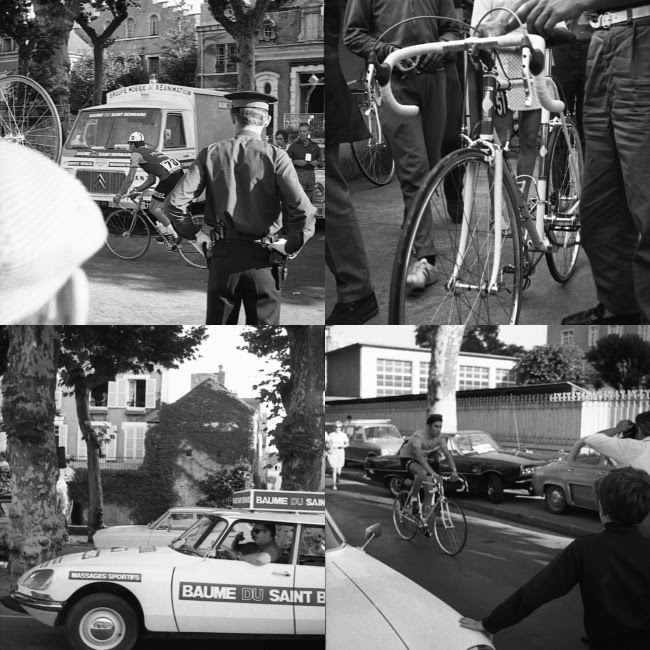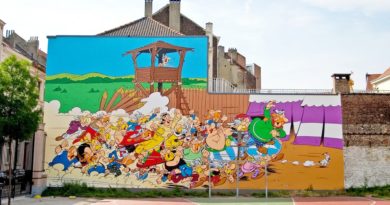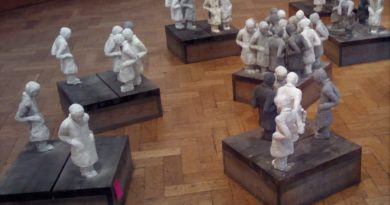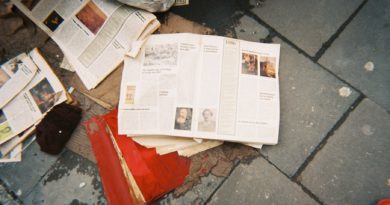Review of Jef Geys’ new photo exhibition at Bozar: “The Tour de France 1969 of Eddy Merckx”
A new exhibition of Jef Geys’ (1934-2018) photographic work opened this Friday, May 17th, at Bozar. The exhibition – which is free to the general public and is scheduled to run until the 1st of September – consists of 67 never-before-published photos taken by the famous Belgian artist over a period of two weeks during the 1969 Tour de France. The photos are complemented by the curators’ addition to the collection of the original front pages of two Belgian national newspapers, dated July 21, 1969: the exact day after Eddy Merckx won the Tour for the first time and also, of course, the day after the first moon landing.
For the most part, the photographs feature a miscellany of largely anonymous individuals – including policemen, spectators, and amateur and professional cyclists – appearing in anonymous French and Belgian towns, mostly performing mundane tasks such as walking, waiting, eating, and talking. Such photographs are (very) occasionally juxtaposed with photos of the great Merckx himself, similarly engaged in mostly quotidian endeavours. (Given that his name appears in the exhibition’s title, I was slightly surprised to discover that a mere four photographs in the entire collection actually feature the great Belgian.)
Interestingly, the official press release for the exhibition assures us that such juxtaposition is, in fact, a classic Geysian trope: “The theme of [Geys’] photographic reportage is not to show the glamour of the race toward triumph, but the merging of the unusual and the everyday in the life of the cyclist. In his art Jef Geys weaves different levels together and puts them on an equal footing … e.g. a famous racing cyclist next to an ordinary cycling enthusiast. In this exhibition Geys again demonstrates his mastery of the contrast of High and Low.”
Similarly, the mini-biography of Geys published in the exhibition’s flyers notes that Geys “explor[ed] every aspect of his daily environment without ranking them”, before remarking that “photography has always been Jef Geys’ defining medium”, and that Geys possessed “an acute sense for artistic production”. These sentiments were also echoed by Sylvie Boulanger, one of the two co-curators of the exhibition, who stated yesterday at the exhibition’s opening ceremony that: “Geys was incredible. He took everything and elevated it to the level of art. He abolished hierarchies.”
Suggestive though many of these interpretative remarks undoubtedly are, they are also – upon reflection – seriously confusing. For one thing, “contrasting” the themes of “High and Low” culture would appear to be a distinct artistic endeavour to “placing [them] on an equal footing”, for the straightforward reason that that which is “equal” cannot coherently be “contrasted”. (In other words: to contrast dissimilar themes or images is not equivalent to equalising that which is superficially or initially distinct.) Furthermore, Geys’ tendency to “not rank” different aspects of his environment is similarly difficult to square with the thesis that he also possessed an “acute sense for artistic production” – for surely such an acute sense can only reasonably be said to exist in someone in possession of the relevant ability to determine what, exactly, is artistically significant.

Moreover – and most crucially – the claim that “photography has always been Jef Geys’ defining medium” is extraordinarily difficult, if not impossible, to reconcile with the fact that so many of the photos are manifestly amateurish in quality: in addition to a large proportion of them featuring nothing of any discernible interest whatsoever, many of them are blurred, a few are oddly tilted, and some even feature major obstacles in the camera’s line of sight.
Surprisingly, such an assessment of the photographs’ quality is one that is shared by the other co-curator of the exhibition, Francis Mary, who noted at the opening ceremony yesterday that, although the photos are “not professional”, this “does not matter” because “what is important is the recreation of the atmosphere and the scenery of a particular moment in history.” But such a remark – though contentious in and of itself – in turn only raises another obvious question: How are we supposed to admire this work by Geys – someone who, the exhibition’s press release assures us, was a “pioneer in the Belgian art world” and “one of the most influential post-war Belgian artists” – when he was, according to one of the exhibition’s own curators, a complete and utter amateur in his own “defining medium”?
Arguably, the only (somewhat) interesting part of the Jef Geys exhibition has little to do with Jef Geys at all, but instead involves the aforementioned archived front pages of the two Belgian newspapers chosen by the curators, namely De Standaard and Het Nieuwsblad. Most notably, De Standaard’s front page fails to even mention Eddie Merckx, but instead devotes all of its space to covering the moon landing, while Het Nieuwsblad gives roughly equal space to both the moon landing and Eddie Merckx’s Tour victory.
Het Nieuwsblad’s implicit suggestion of parity between these two events will strike many readers as utterly preposterous, perhaps even comically so. However, given the nature and overall theme of the exhibition, an alternative interpretation naturally suggests itself: Are the curators, perhaps, simply attempting to reinforce the Geysian theme of contrasting (or equalising) “High and Low”, this time by juxtaposing what is arguably the highest pinnacle of human scientific achievement with the relative low of a victory in an annual sporting event that few people outside – or for that matter, even inside – Western Europe care(d) about?
(For what it’s worth, my own view is that such interpretative charity would be unwarranted – or, at the very least, as unwarranted as the interpretative charity that the curators appear willing to extend to Geys.)
During her remarks yesterday, Ms Boulanger related a comment that Geys once made to her in a private email: “My mother [wrote Geys] gave me some good advice: be wise… and the rest I’ve forgotten.” Vapid though this advice is, one can’t help escape the feeling that, had Ms Boulanger truly adhered to it, this exhibition probably wouldn’t exist at all.



